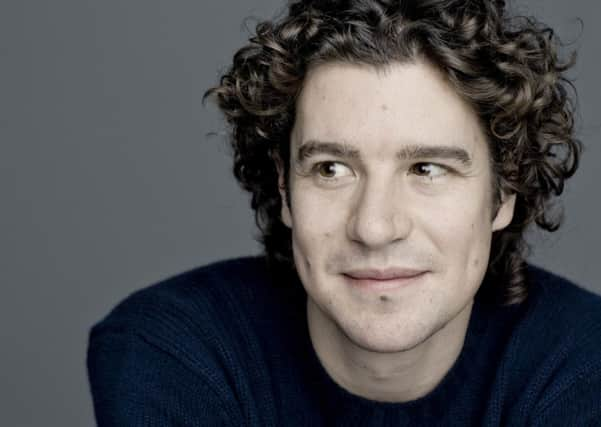Interview: SCO principal conductor Robin Ticciati on playing big symphonies with a small orchestra


But what happens if a chamber orchestra tackles a work traditionally performed by an orchestral behemoth? Robin Ticciati, Principal Conductor of the Scottish Chamber Orchestra, is convinced that the SCO’s forthcoming performances of Anton Bruckner’s Fourth Symphony – the “Romantic” – will reveal the work in new colours. “We need to scrape back the veneer,” he argues, encouraging audiences and players alike to approach this late 19th-century masterpiece afresh.
Ticciati and the SCO arrive at Bruckner after plotting a course over the past few seasons through the music of Berlioz, Schumann and Brahms. “I can’t claim there’s an inexorable logic behind this particular route,” says Ticciati, “but I do know that my experiences with Brahms last season were a catalyst for tackling Bruckner”.
Advertisement
Hide AdAdvertisement
Hide AdThe pairing is intriguing. In the later 19th century the two composers were viewed as polar opposites. Brahms was seen as a musical conservative, reluctant to espouse the experiments in harmony and form that Wagner and his acolytes advocated. By the end of his life, Bruckner had been adopted by Vienna as the leader of the progressives – a true disciple of Wagner who found a way of transferring the latter’s awe-inspiring edifices from opera house to concert hall.
There was certainly no love lost between the two composers. Brahms was scathing about Bruckner’s symphonic “boa constrictors”, and Bruckner, in turn, saw no merit in Brahms’s dry academicism. With hindsight, we can see the folly of both perspectives, and the two composers emerge much closer than their contemporaries could ever have allowed. For Ticciati, it’s the combination of head and heart in Brahms’s music that is so engaging. But Bruckner’s music, he argues, is not so different. Bruckner, like Brahms, took years out of composition to train in counterpoint – according to Schumann, the most difficult of the arts. However, over time he perfected a style that also embraces delicate orchestral colours alongside climaxes of unprecedented power.
“I’ve spent the last eight to ten years exploring Bruckner with large orchestral juggernauts”, Ticciati explains, alluding to his work with some of the finest symphony orchestras in Europe. “It’s hard to overstate the thrill of performing this music with a big orchestra. Their golden, thick, overwhelming sound can be captivating.” And it’s not just about extra volume: Ticciati points to the very special lustre achieved by ten double basses playing a low C pianissimo.
There is, however, a flip side. “When you’ve got lots of players, it’s much harder to achieve immediacy.” Ticciati sees the advantages of flexibility in the SCO’s smaller ensemble: it allows risk-taking and, crucially, encourages an interpretation built round musical gesture. “Of course, Bruckner’s music needs long lines, but do those lines have to be rigid? Could they be more curved? Could there be more ebb and flow?” Having spent the past season working on Brahms, a composer famed for his love of flexible tempi, the SCO is well-placed to offer an answer.
“It’s a question of working out who Bruckner is,” Ticciati continues. “I want to explore the myths that surround him.” He was certainly devout. No contemporary composer was so obsessed with religion, and the symphonies have often been seen as secular equivalents of the massive organ improvisations for which Bruckner was famed. His “granite-like structures”, to quote Ticciati again, certainly suggest the manuals of a cathedral organ, and no 19th century composer was able to deliver comparable visions of heaven.
But there’s much more to Bruckner than this. The “Romantic” Symphony also conjures up pictures of nature. The earthy sound of the brass instruments used for this project – which include Waldhorns (literally “horns of the forest”) – is far removed from the satiny perfection of standard orchestral brass; it brings, says Ticciati, “a pictorial element into our sound-world”. Backed up by the more rasping sound of small-bore trombones and timpani covered in calfskin, the horns evoke the Austrian countryside; this clearly nourished Bruckner just as much as Beethoven and Brahms or, later, Mahler.
The strings too have a role to play. The “Romantic”, like almost every Bruckner symphony, starts with a shimmering string texture, a tremolo against which an adamantine theme gradually emerges, usually in distant brass. It’s as though Bruckner wished to recreate a forest waking at dawn. In a large symphony orchestra the effect can be magical. “But”, asks Ticciati, “must it always be a carpet of gold? Could it perhaps be rather more ‘gutty’.”
Using valveless brass instruments
Advertisement
Hide AdAdvertisement
Hide Adalso introduces subtle nuances of tuning, thereby adding flecks of colour to the aural portrait. Ticciati believes this will be apparent even in the famous opening horn theme which, though based on the natural harmonic series, is heightened by one critical chromatic note.
It’s true that in Scotland Bruckner is almost always performed by large symphony orchestras. “There’s a risk,” says Ticciati, “of the composer being set in aspic.” This season’s innovative programming echoes the views of Donald Francis Tovey, long-time Reid Professor at Edinburgh University, who once claimed that we have to hear Bruckner’s music as if we don’t know it. Ticciati invites us to an exercise in constructive defamiliarisation: “Come and see Bruckner in different clothes!”
The SCO perform Bruckner’s “Romantic” Symphony at the Usher Hall, Edinburgh on 3 November and at City Halls, Glasgow on 4 November, www.sco.org.uk